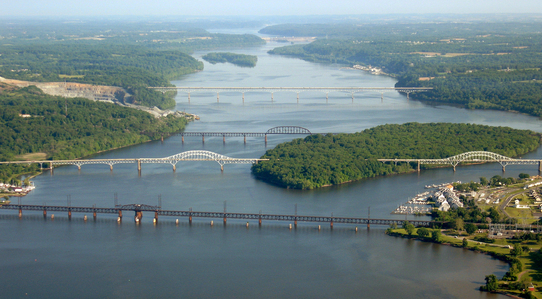Imagine you live in Havre de Grace, Maryland. Congratulations: It’s a lovely, quaint little town. I’ve enjoyed stopping by on my way between DC and Philly, eating ice cream and watching sailboats bobble in the water where the Susquehanna River spills into the Chesapeake Bay.

Now let’s imagine you work in Baltimore. You want to take the MARC train to work. Lucky you: You live about a mile from the Perryville train station, as the crow flies. But you’re not a crow. So you’d like to ride your bike there.
There are four bridges that cross the Susquehanna River between Havre de Grace and Perryville, Maryland, and none of them allow people to walk or bike across.
To do that, according to Google Maps, you’d have to go about 12 miles north of Havre de Grace (and the most natural route up the Northeast Corridor) and cross on the Conowingo Road bridge, where walking and biking is technically permitted. But there is no walkway on the Conowingo Road bridge, or even a shoulder, and the bridge is a mile long with heavy car traffic at times. If you want to cross safely, you’ll have to go 48 miles north and west to cross the river near York, Pennsylvania.
That’s right: There’s not a single bridge in the state of Maryland that will take you across the Susquehanna River safely on a bike or on foot.
So if you live in Havre de Grace and want to get to the MARC station in Perryville, or anywhere else north and east of your house, you’re going to have to do it in a car.

The East Coast Greenway Alliance is trying to change that. Maryland is in the process of designing a replacement for the 108-year-old Amtrak bridge over the Susquehanna River, which carries well over 100 trains every weekday. U.S. DOT gave the state $22 million for the engineering and environmental work to replace the bridge three years ago. Right now, Maryland is conducting its environmental impact review -- meaning right now is the time for community input.
The Alliance mobilized at just the right moment. It's talking to MDOT and its members of Congress and the state legislature and organizing local support for bike/ped access to the new bridge. On Tuesday, the Alliance launched the Susquehanna Safe Crossing Coalition, and Monday its members will speak out at a public meeting on the bridge design.
The Alliance is working to build a 2,900-mile bike and pedestrian trail from Key West, Florida, to the Canadian border at Calais, Maine. Right now, 29 percent of it is off-road, with the rest on “carefully-selected roadways.” The Susquehanna crossing is the greenway’s single biggest obstacle.
“The East Coast Greenway now relies on public transit to get across bridge -- or you call a taxi,” said Andy Hamilton of the Alliance. “And public transit only operates Monday through Friday during work hours and rush hour. So if you happen to want to cross the river on a Saturday or Sunday, you are paying for a cab.”
The state of Maryland, with its smart-growth-minded, pro-transit Governor Martin O'Malley, has been friendly to the greenway, paying for signage along the route. But it hasn’t yet committed to making the new Amtrak bridge accessible to people walking and biking. Other major bridges in Maryland force cyclists to find a taxi that will load their bikes, too; most notably, the Bay Bridge across the Chesapeake to Maryland's Eastern Shore prohibits bicycling and walking.
Aside from the obvious recreational benefits of connecting the greenway, there are countless commutes and other trips that will be made possible by providing access. More than 16,000 people work at the Aberdeen Proving Ground, an Army base a few miles southwest of Havre de Grace. The Perryville casino attracts thousands of workers and gamblers every day. A VA medical center and a massive IKEA distribution center in Perryville also employ several hundred people.
These are not high-paying jobs, notes Hamilton. “There is a need to cross that river without having to have a vehicle that costs you $3,500 a year, and then $4 a day for crossing,” he says. “That’s the toll at the Hatem bridge -- which is a wonderful name for it.”
A petition urging Maryland to build bike and pedestrian access into the new Amtrak bridge has already garnered nearly 7,500 signatures online.





